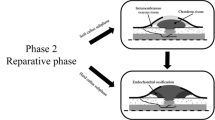Abstract
A first order system model is proposed for simulating the influence of stress stimulation on fracture strength during fracture healing. To validate the model, the diaphyses of bilateral tibiae in 70 New Zealand rabbits were osteotomized and fixed with rigid plates and stress-relaxation plates, respectively. Stress shielding rate and ultimate bending strength of the healing bone were measured at 2 to 48 weeks postoperatively. Ratios of stress stimulation and fracture strength of the healing bone to those of intact bone were taken as the system input and output. The assumed first order system model can approximate the experimental data on fracture strength from the input of stress stimulation over time, both for the rigid plate group and the stress-relaxation plate group, with different system parameters of time constant and gain. The fitting curve indicates that the effect of mechanical stimulus occurs mainly in late stages of healing. First order system can model the stress adaptation process of fracture healing. This approach presents a simple bio-mathematical model of the relationship between stress stimulation and fracture strength, and has the potential to optimize planning of functional exercises and conduct parametric studies.
Similar content being viewed by others
References
Ament, C., Hofer, E.P., 2000. A fuzzy logic model of fracture healing.Journal of Biomechanics,33:961–968.
Bailón-Plaza, A., van der Meulen, M.C.H., 2001. A mathematical framework to study the effects of growth factor influences on fracture healing.Journal of Theoretical Biology,212:191–209.
Blenman, P.R., Carter, D.R., Beaupré, G.S., 1989. Role of mechanical loading in the progressive ossification of a fracture callus.Journal of Orthopaedic Research,7:398–407.
Carter, D.R., Blenman, P.R., Beaupré, G.S., 1988. Correlations between mechanical stress history and tissue differentiation in initial fracture healing.Journal of Orthopaedic Research,6:736–748.
Claes, L.E., Heigele, C.A., 1999. Magnitudes of local stress and strain along bony surfaces predict the course and type of fracture healing.Journal of Biomechanics,32:255–266.
Claes, L.E., Wilke, H.J., Augat, P., Rübenacker, S., Margevicius, K., 1995. Effect of dynamization of gap healing of diaphyseal fractures under external fixation.Clinical Biomechanics,8:227–234.
García, J.M., Kuiper, J.H., Doblaré, M., Richardson, J.B., 2002. A numerical model to study the mechanical influences on bone fracture healing.Acta of Bioengineering and Biomechanics,4:394–395.
Gardner, T.N., Stoll, T., Marks, L., Mishra, S., Knothe, T.M., 2000. The influence of mechanical stimulus on the pattern of tissue differentiation in a long bone fracture-an FEM study.Journal of Biomechanics 33:415–425.
Goodship, A.E., Kenwright, J., 1985. The influence of induced micromovement upon the healing of experimental tibial fractures.Journal of Bone and Joint Surgery,67:650–655.
Pauwels, F., 1960. A new theory concerning the influence of mechanical stimuli on the differentiation of the supporting tissues.Z Anat. Entwicklungsgeschichte,121:478–515.
Zhang, X.L., Zhang, W., Dai, K.R., 2000. Experimental study of effect of stress-relaxation bone on fracture healing.Chinese Journal of Traumatology,3(4):195–201.
Author information
Authors and Affiliations
Corresponding author
Additional information
Project (No. 39470698) supported by the National Natural Science Foundation of China
Rights and permissions
About this article
Cite this article
Xiao-ping, W., Xian-long, Z., Zhu-guo, L. et al. A first order system model of fracture healing. J. Zheijang Univ.-Sci. B 6, 926–930 (2005). https://doi.org/10.1007/BF02841005
Received:
Accepted:
Issue Date:
DOI: https://doi.org/10.1007/BF02841005




